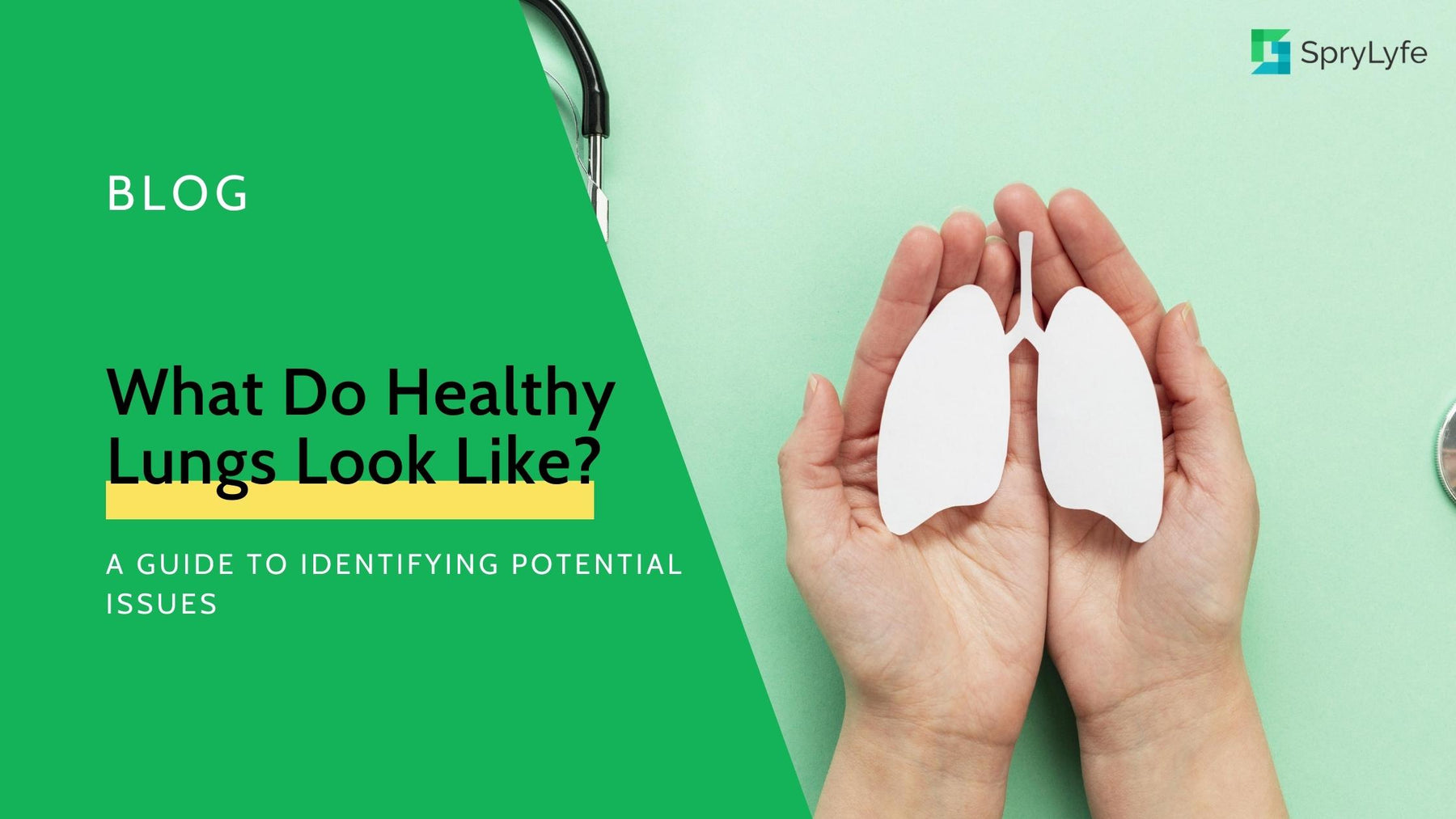
What Do Healthy Lungs Look Like? A Guide to Identifying Potential Issues
Do healthy lungs look like a vital part of your body, or are they often overlooked? Our lungs are essential for providing us with oxygen and helping to eliminate waste from our bodies. Unfortunately, many people don't think about their lung health until it's too late.
Knowing what healthy lungs should look like can help you identify potential issues before they become serious problems. In this blog post, we'll explore the anatomy of healthy lungs, how to spot signs that something is wrong, and various treatment options available for respiratory conditions affecting the lungs.
Join us as we answer the question: do healthy lungs look like?
What Do Healthy Lungs Look Like?
The lungs are a pair of organs located in the chest that play an essential role in breathing. They are responsible for taking oxygen from the air we breathe and transferring it into our bloodstream, while also removing carbon dioxide from our blood and expelling it back out through exhaling.
Anatomy of the Lungs
The lungs are made up of many different parts, including bronchi, alveoli, pulmonary arteries and veins, pleura, diaphragm and lymph nodes.
The bronchi are two tubes that branch off from the trachea (windpipe) to enter each lung. Inside each lung is a network of smaller tubes called bronchioles which lead to tiny sacs known as alveoli where gas exchange takes place between inhaled oxygen and exhaled carbon dioxide.
Blood vessels carry oxygen-rich blood away from the alveoli to other parts of the body via pulmonary arteries while veins bring deoxygenated blood back to be re-oxygenated by the lungs again. The pleura is a thin membrane surrounding each lung that helps keep them lubricated so they can move freely during breathing movements.
Lastly, there’s your diaphragm – a large muscle at the base of your ribcage which contracts when you inhale allowing air to fill your lungs with fresh oxygen and expand outward before relaxing when you exhale pushing used air out again.
Normal Lung Function
During inhalation, clean air enters through your nose or mouth and passes down into your windpipe (trachea), then splits off into two branches known as bronchi which further divide into smaller branches until reaching microscopic sacs called alveoli.
Gas exchange takes place between incoming oxygen molecules being absorbed by red blood cells within capillaries found around these sacs while simultaneously releasing waste products like carbon dioxide back out through exhalation.
This completes one full cycle per breath taken naturally without conscious effort required on our part thanks largely due to its automated nature making us unaware most times of just how much work goes on inside us constantly keeping us alive.
How to Identify Potential Issues with Your Lungs
It is important to be aware of the signs and symptoms that may indicate a problem with your lungs. Common signs include:
- shortness of breath
- wheezing
- coughing up mucus or blood
- chest pain or tightness
- fatigue
- rapid breathing
If you experience any of these symptoms on a regular basis it is important to see your doctor for further evaluation.
Diagnostic Tests for Lung Health
Your doctor will likely order tests such as an X-ray or CT scan to get a better look at what’s going on inside your lungs.
Other tests such as pulmonary function tests can measure how well air moves in and out of your lungs while spirometry measures how much air you can exhale in one second.
Your doctor may also take samples from the lining of your nose or throat if they suspect an infection causing lung problems.
How to Improve Your Lung Health
Here are some tips on how to improve your lung health.
Quitting Smoking and Avoiding Secondhand Smoke
Quitting smoking is one of the most important steps you can take to improve your lung health. Cigarette smoke contains thousands of chemicals that damage your lungs, leading to a variety of respiratory conditions including COPD, asthma, and cancer.
If you are unable or unwilling to quit smoking, avoiding secondhand smoke is essential for protecting your lungs from further damage.
Exercise and Physical Activity
Regular exercise has many benefits for overall health but it also helps keep your lungs healthy by increasing oxygen intake and improving breathing efficiency.
Aim for at least 30 minutes of moderate physical activity each day such as walking, jogging, swimming or biking. You should also do strength training exercises two days per week to build muscle mass which will help support proper breathing technique during exercise.
Eat a Balanced Diet
Eating a balanced diet rich in fruits, vegetables, whole grains and lean proteins can help reduce inflammation in the body which may lead to better lung function over time.
For a more detailed discussion on what to eat for better lung health, read this article.
Also, maintaining an ideal weight range through regular exercise and healthy eating habits can help reduce strain on the heart, leading to improved blood flow throughout the body including the lungs.
By making positive lifestyle changes, such as quitting smoking and exercising regularly, you can improve your lung health and reduce the risk of developing respiratory conditions. Next, let's look at some common respiratory conditions that affect the lungs.
Read more about how to improve and strengthen your lungs here.
Common Respiratory Conditions Affecting the Lungs
Asthma
Asthma is a chronic respiratory condition that affects the airways, causing them to become inflamed and narrowed. Symptoms of asthma include:
- shortness of breath
- wheezing
- coughing
- chest tightness
- difficulty breathing
Asthma can be triggered by allergens such as pollen or dust mites, cold air or exercise. Treatment for asthma includes avoiding triggers when possible and using medications such as inhalers to reduce inflammation in the lungs.
COPD
Chronic Obstructive Pulmonary Disease (COPD) is a progressive lung disease characterized by airflow obstruction due to inflammation of the airways caused by smoking or long-term exposure to other irritants like pollution.
Symptoms of COPD include:
- persistent cough with mucus production
- shortness of breath during physical activity
- increased susceptibility to respiratory infections
Treatment for COPD typically involves quitting smoking if applicable, taking medication such as bronchodilators and inhaled steroids to reduce inflammation in the lungs and oxygen therapy if needed.
Respiratory conditions can be serious and even life-threatening, but with proper treatment and lifestyle changes, they can be managed.
To learn more about the different treatment options available for respiratory conditions, read on to find out more about medications, oxygen therapy and surgery.
Treatment Options for Respiratory Conditions
Medications for Respiratory Conditions
Medication is often the first line of defense when it comes to treating respiratory conditions.
Common medications used to treat asthma, COPD, and other respiratory diseases include
- Bronchodilators
- Corticosteroids
- Antibiotics
- Immunomodulators.
Bronchodilators help open up airways by relaxing muscles in the lungs while corticosteroids reduce inflammation in the airways.
Antibiotics are used to fight bacterial infections that can cause pneumonia or bronchitis while immunomodulators help strengthen the immune system against certain types of bacteria and viruses.
Oxygen Therapy for Respiratory Condition
Oxygen therapy is a common treatment option for people with COPD or other serious lung diseases who have difficulty breathing on their own due to low oxygen levels in their blood.
Oxygen therapy involves using a portable oxygen concentrator (POC) which takes room air and filters out nitrogen so that only pure oxygen is delivered directly into your lungs via nasal cannula or mask.
This helps increase oxygen levels in your bloodstream which can improve overall health and quality of life as well as reduce symptoms like shortness of breath and fatigue associated with COPD or other chronic lung diseases.
Frequently Asked Questions
How do you know if your lungs are healthy?
The best way to know if your lungs are healthy is to get a lung function test. This can be done at your doctor’s office and will measure how much air you can inhale and exhale, as well as the speed of your breath.
Your doctor may also order additional tests such as chest X-rays or CT scans to check for any abnormalities in the lungs.
Other signs that indicate good lung health include having no shortness of breath during exercise, being able to speak without difficulty, and not experiencing coughing fits when exposed to allergens or pollutants.
If you experience any of these symptoms it's important to see a doctor right away so they can determine what might be causing them.
How do I know if my lungs are damaged?
If you have difficulty breathing, experience chest pain or tightness, wheezing, coughing up blood or mucus, and/or fatigue that doesn't improve with rest then it is possible your lungs are damaged. A doctor can provide a diagnosis through tests such as a pulmonary function test (PFT), chest X-ray, CT scan of the lungs, and/or bronchoscopy. These tests will help determine if there is any damage to the airways or alveoli in the lungs. Treatment for lung damage depends on its cause and severity but may include medications to reduce inflammation and infection as well as oxygen therapy to help increase oxygen levels in the body.
What color are healthy lungs
Healthy lungs are typically a light pink color. This is because they contain tiny blood vessels that carry oxygenated blood throughout the body.
The oxygen in the air we breathe passes through these vessels and gives them their characteristic hue. When someone has an illness or condition affecting their lungs, such as COPD or asthma, the color of their lungs may be different due to inflammation and other changes in tissue structure.
It's important to get regular check-ups with your doctor if you have any respiratory issues so that they can monitor your lung health and help you manage it effectively.
What do your lungs look like after smoking?
The long-term effects of smoking on the lungs are devastating. Over time, the smoke from cigarettes damages and destroys lung tissue, making it harder to breathe.
The walls of air sacs in the lungs become thickened and inflamed due to smoking, reducing their ability to take in oxygen. Tar deposits also build up in the lungs, further blocking airflow and leading to a host of respiratory problems like COPD and asthma.
In severe cases, smokers can develop emphysema or even cancer as a result of their habit. Ultimately, smoking leads to an overall decrease in lung function that can be irreversible if not addressed quickly enough.
Conclusion
In conclusion, it is important to understand what healthy lungs look like and how to identify potential issues. Regular check-ups with your doctor can help you keep an eye on any changes in your lung health.
Additionally, making lifestyle changes such as quitting smoking or exercising regularly can help improve the overall condition of your lungs. Understanding the common respiratory conditions that affect the lungs and knowing about available treatment options are also essential for maintaining good lung health.
By understanding what healthy lungs look like and taking steps to protect them, you can ensure that you have a better quality of life now and in the future.
Written by Andy Flynn

|
Andy Flynn is the founder of Sprylyfe, the leading retailer of portable oxygen concentrators in the United States. He also co-founded ARYA BioMed. Get to know him on LinkedIn. |
Medically Reviewed By Aaron Gravely, M.D.

|
Aaron L. Gravely, M.D. is a professional medical writer and physician-scientist with over 8 years of experience in healthcare and medical research. Get to know him on LinkedIn or read his published works. |


Leave a comment